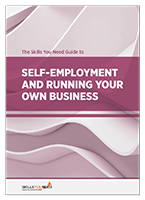Basic Accounting Skills
Every Entrepreneur Should Know
See also: Understanding Investing
Deciding to start your own business is exciting. You can pursue a passion, be your own boss, and control your own success. But chances are there’s an aspect of entrepreneurship that’s a little (or a lot) less appealing: handling your accounting.
While accounting isn’t as glamorous as selecting a business name and logo, it’s just as important. After all, if you don’t stay on top of your cash flow, pay creditors, and file tax returns, your business won’t last long.
Even if you plan on outsourcing your accounting from day one, it’s a good idea to understand a few simple concepts and have some basic accounting skills. This article will help you start building that foundation.
Set up and maintain a chart of accounts
A chart of accounts is a listing of all of the financial accounts in your general ledger. Every company’s chart of accounts is different, depending on its size, the types of activities it engages in, and transactions that need to be reflected in its books.
According to Accounting Coach, the chart of accounts for an international corporation with several divisions might have thousands of accounts, whereas a small business might have a few dozen.
While most accounting software has a built-in chart of accounts, you can add, delete, and edit accounts as needed. So, make sure your chart of accounts works for you and how you actually run your business, added Kenan Acikelli - CEO & Co-founder at Workhy.
But keep in mind that while you can add as many accounts as you need, you should avoid creating too many accounts. You don’t need separate accounts for every transaction, customer, department, utility, or supplier. A bloated chart of accounts just leads to immaterial balances in accounts and hinders meaningful analysis.
Preparing (and using) a budget
Knowing how to prepare and use a budget is an essential business task. Budgeting ensures you know where your business stands and whether you need to decrease your spending or increase your revenue to hit your goals.
Knowing how to prepare a budget is also essential if you want outside funding since lenders and investors typically want to see a detailed budget that outlines your projected revenues and expenses.
Do some research and number crunching to prepare a reasonable budget that reflects:
Revenues
Fixed and variable expenses
One-time spending and investments
Setting aside cash for a business emergency fund
Repaying loans and other debts
Paying yourself and returning a profit to investors
If you’re brand new in business, these numbers might seem like a guessing game, but start with conservative educated guesses. You can always refine and revise your budget over time. Microsoft has a helpful Business Expense Budget template for Excel that can get you started.
Once you have a budget, remember it’s a living document—not something you look at once a year! Set aside time each week to compare your actual numbers to your budget, make adjustments as necessary, and avoid common financial mistakes.
Understand fixed vs. variable costs
Managing costs is a critical priority for any business owner. Even if your business is generating substantial revenue, you won’t be in business long if you're not controlling costs. Part of controlling costs is understanding the difference between fixed and variable costs.
Fixed costs don’t change even when your sales volumes or production levels increase. This generally includes things like rent, liability and property insurance, management salaries, and interest on loan payments.
Variable costs are directly impacted by changes in the volume of products or services your company produces. This includes things like direct labor, sales commissions, raw materials, packaging supplies, and shipping costs.
Understanding fixed vs. variable costs is essential because it helps you determine a price for your products or services and calculate your break-even point, which is a must if you want to be profitable.
Break-even point = fixed costs / (price - variable costs)
Businesses with higher fixed costs generally have a higher break-even point, meaning they need to sell more products or services in order to turn a profit.
Manage cash flow—not just profits
Profit and cash flow are both crucial for a successful business, but they’re not the same thing, and business owners run into trouble when they don’t understand the difference.
Profit is simply your business’s revenue minus expenses, while cash flow refers to how and when cash comes into and goes out of your business. Many businesses are profitable but experience negative cash flow. This usually happens when companies allow clients to pay for goods or services on credit.
For example, if you make a $10,000 sale on credit, your profit and loss statement will show $10,000 of revenue. But that $10,000 of revenue isn’t cash in the bank—it’s an account receivable. Until your customer pays the invoice, you can’t use that money to pay rent, buy inventory, or pay other necessary business expenses.
Selling to customers on credit can be an excellent way to encourage sales. But it’s crucial to ensure that you have enough cash coming in to cover the money that needs to go out. You can do this by creating a cash flow forecast.
A cash flow forecast is a lot like a budget, but rather than estimating revenues and expenses, it forecasts cash coming in and going out of the business. This allows you to spot potential cash shortages before they arise and make a plan for dealing with them.
Microsoft has a good Excel cash flow projection template you can use to get started.
Don’t forget about taxes
US federal income taxes for businesses are complex, so it’s a good idea to outsource preparing and filing tax returns to your CPA or tax advisor.
But don’t wait until year-end to think about taxes. As a business owner, you’re generally required to pay estimated taxes four times per year—April 15, June 15, September 15, and January 15 of the following year.
Missing those deadlines can prove costly, so set aside a portion of your monthly profits to ensure you have money available when it’s time to make estimated tax payments.
How much should you set aside? That depends on your business structure and location, but according to Bench, 30-40% of business income is a good rule of thumb. Reach out to your tax advisor for a more personalized estimate.
Further Reading from Skills You Need
The Skills You Need Guide to Self-Employment and
Running Your Own Business
If you are thinking about running your own business, or already do so, but feel that you need some guidance, then this eBook is for you. It takes you through self-employment in easy steps, helping you to ensure that your business has more chance of success.
The Skills You Need Guide to Self-Employment and Running Your Own Business is the guide no new or aspiring entrepreneur can afford to be without!
Based on our popular self-employment and entrepreneurship content.
As a business owner, you don’t have to become an accounting expert—there are plenty of professional accountants you can call on to deal with the details. But establishing a basic foundational knowledge of accounting and taxes helps you understand what’s going on in your business and whether you have enough cash in the bank to cover your bills and pay your taxes. This knowledge can help you become a better decision maker and avoid financial pitfalls that bring other budding entrepreneurs down.

About the Author
Mike Whitmire, CPA*, is CEO and Co-founder of FloQast, a provider of accounting workflow automation software created by accountants for accountants to help them work smarter, not harder. A proud Angeleno, Mike is a big Los Angeles Dodgers fan and an avid baseball card collector. He resides in LA with his wife and daughter.


